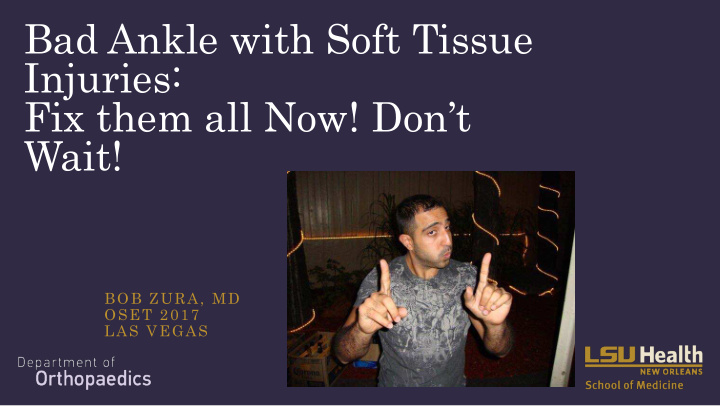



Bad Ankle with Soft Tissue Injuries: Fix them all Now! Don’t Wait! BOB ZURA, MD OSET 2017 LAS VEGAS
Disclosures • Consultant: – Smith-Nephew – Bioventus – Cardinal Health
https://orthointerview.com/News/files/painful-tendon-after-severe-ankle-fracture-21312561.jpg
https://images.search.yahoo.com/search/images;_ylt=AwrBT6PYeyFarK8AoKZXNyoA;_ylu=X3oDMTB0N2Noc21l BGNvbG8DYmYxBHBvcwMxBHZ0aWQDBHNlYwNwaXZz?p=medial+ankle+surgical+incisions&fr2=piv- web&fr=yset_chr_syc_oracle#id=69&iurl=https%3A%2F%2Fi.ytimg.com%2Fvi%2Ffdu2vgZMvrw%2Fmaxresdefau lt.jpg&action=click
Case
Case
Case
Case
Case:
This is really about soft tissue • Yes – you can wait, but…. – Easier if wound vac – What if you closed the skin • Wait until it heals? • Re-open? • What options does the soft tissue envelope/injury give you? • The question is: – Is it safe to the soft tissues to fix early? Assumption – the open fracture is adequately clean and does not require redebridement.
Immediate internal fixation of open ankle fractures. J Orthop Trauma. 1988. Wiss DA, Gilbert P, Merritt PO, Sarmiento A. • 76 open ankles treated with immediate fixation • Seventy-two percent of the patients had a satisfactory result • Deep infection occurred in 5% of the patients • We believe immediate internal fixation is the treatment of choice for displaced open ankle fractures, but this form of treatment does have a significant rate of complications.
Treatment of open ankle fractures. Immediate internal fixation versus closed immobilization and delayed fixation. Clin Orthop Relat Res. 1989. Bray TJ, Endicott M, Capra SE. • Thirty-one open ankle fractures – 15 delayed – 16 immediate • One case in each group became infected • Functional scores at follow-up examination were the same • immediate showed less impairment of range of motion but had a greater incidence of chronic ankle swelling • Significant shorter LOS for immediate • Faster recovery with no more infection
Open ankle fractures. The indications for immediate open reduction and internal fixation.Review article Clin Orthop Relat Res. 1993. Johnson EE, Davlin LB. • 22 open ankles treated with immediate fixation • There were six Grade I (27%), 15 Grade II (68%), and one Grade III (5%) injuries. • Excellent results were achieved in 14 patients (64%); good results in five (23%), and poor results in three (13%). • There were no deep infections or nonunions. • Immediate debridement, irrigation, reduction, and internal fixation of open ankle fractures is clearly indicated in Grade I and clean Grade II open injuries.
Does this apply to “modern” literature?
The results of early primary open reduction and internal fixation for treatment of OTA 43.C-type tibial pilon fractures: a cohort study. White TO, Guy P, Cooke CJ, Kennedy SA, Droll KP, Blachut PA, O'Brien PJ. JOT 2010 • 95 pilons • Primary ORIF was performed within 24 hours in 70% of cases and within 48 hours in 88%. Six patients developed a deep wound infection or dehiscence that required surgical débridement, four after open – fractures (four of 21 [19%]) and two after closed fractures (two of 74 [2.7%]). • Provided surgery is performed expeditiously by experienced orthopaedic trauma surgeons, most tibial pilon fractures can be stabilized by primary ORIF within a safe and effective operative window with relatively low rates of wound complications, a high quality of reduction, and functional outcomes that compare favorably with the published results for all other reported surgical treatments of these severe injuries.
• Comparison of Early and Delayed Open Reduction and Internal Fixation for Treating Closed Tibial Pilon Fractures. Tang X1, Liu, Tu CQ, Li J, Li Q, Pei FX. • • If soft tissue conditions are acceptable, early ORIF for treating closed type C pilon fractures can be safe and effective, with: – similar rates of wound complication – fracture union – good functional recovery but shorter operative time, union time, and hospital stay. • These results favorably compare with delayed ORIF treatment.
• Complications and early results after operative fixation of 68 pilon fractures of the distal tibia. Lomax, Singh, N Jane, C Senthil. • • Fixation of these complex fractures in subspecialist units can achieve overall low rates of wound complications, with definitive fixation of selected fractures within 48 h of initial presentation achieving comparable results to those fixed in a delayed fashion. • However, this injury continues to have a significant overall complication rate with a high chance of developing early posttraumatic arthritis and of requiring further surgery.
Summary • These are soft tissue injuries • Must adequately debride and irrigate open fractures • In open injuries – ok (and I think preferable) to fix early – No need to revisit incisions • Personalize the treatment to each case • It is SAFE to fix these early in experienced hands • Complications will still occur as these are devastating injuries
Early is ok, ok with open fractures? • Look to the tibia • We know we can fix early if low grade and clean
Management of Open Tibial Shaft Fractures: Does the Timing of Surgery Affect Outcomes? Duyos, Oscar A. MD; Beaton-Comulada, David MD; Davila-Parrilla, Ariel MD; Perez-Lopez, Jose Carlos MD; Ortiz, Krystal BS; Foy-Parrilla, Christian MD; Lopez-Gonzalez, Francisco MD • Open tibial shaft fractures should be débrided within 24 hours after injury. • Primary reamed intramedullary nailing appears to be a reasonable option for the management of Gustilo-Anderson types 1 and 2 open tibial shaft fractures.
Thank You!
Recommend
More recommend